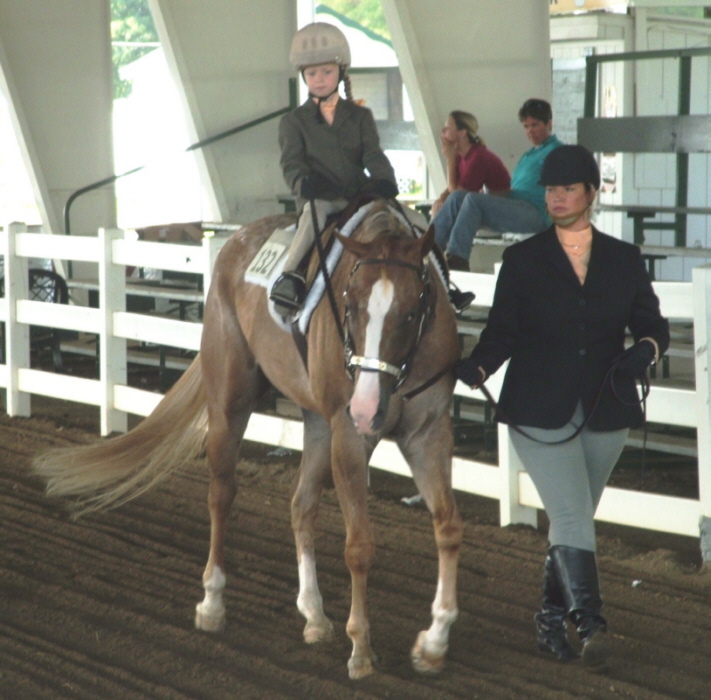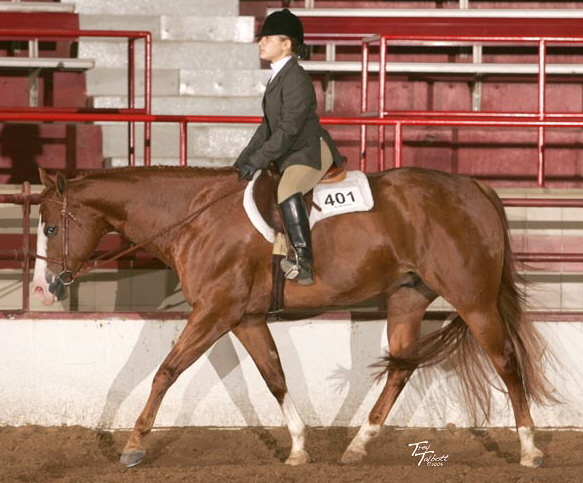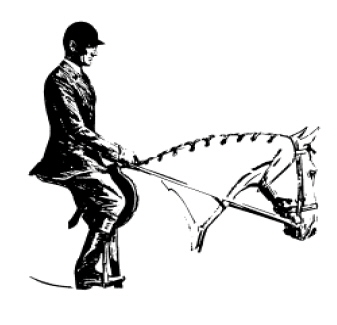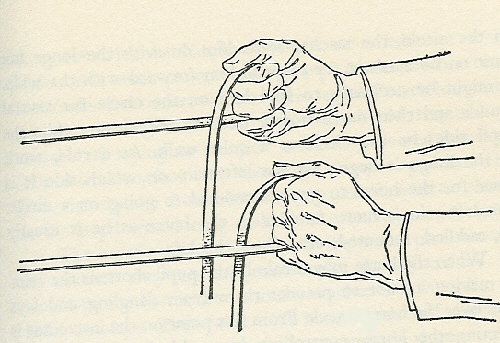IMEHA (International Model Equine Hobbyists Association) was an online photo showing site that existing until 2018. Included on the site were these guidebooks for judging and showing model horses in Performance classes. MEPSA has obtained permission to share the info contained in the guides.
Scoring :: Point Deducts :: Tack :: Rider :: Set-Up Options :: Photo Examples
These classes are seen in the doll rider shows and are judged on manners and performance of the horse and the rider’s ability to handle the horse. Classes are judged 80% on the rider and 20% on the horse. The horse is judged on it’s ability to be a pleasure style mount. The poll should be level with, or slightly above the withers, to allow proper impulsion behind. The head should not be carried behind the vertical, giving the appearance of intimidation, or be excessively nosed out, giving a resistant appearance.
Leadline – 6 and Under
Requires a Youth rider and an Adult doll handler on the ground. Adult handler leading horse is to be dressed in accordance with the Youth exhibitor. Huntseat attire and hunt caps are required for the Youth and the Adult. Halter is placed under the Snaffle bridle and handler leads the rider (with a lead line) around the arena only for safety. Rider, holding the reins, should be able to steer, walk and back their horse. Gaits faster than a walk would not be accurate.
Walk Trot – 10 and Under
Requires a Youth rider that looks to be 10 or under. Rider must be able to steer, back, walk and trot their horse both ways of an arena. Rules for tack and attire for the Youth Walk Trot class are the same as Hunt Seat or Saddleseat Equitation Classes. The Youth Walk Trot class will evaluate the ability of a Youth rider to perform various maneuvers in harmony with his/her horse. The class may include flat work or a pattern. The Youth shall not be asked to canter or hand-gallop.
Horses are judged on their abilities to be a pleasure style mount. Horses are asked to walk or trot both directions of the arena, to stand in a line-up, rein-back and possible other movements at the direction of the judge. Entries should work with a smooth regular gait, a natural willing and responsive headset; not necessarily fully flexed at the poll depending upon breed, conformation and style. They should show a forward – going way of impulsion and conformation consistence with a smooth and sustainable ride such as a well-sloped shoulder, good pasterns, and a supple back with well-developed hind quarters. The demeanor of the horse (model) should be of happy and obedient participation in the class.
Some breeds have a distinct way of going that represent the huntseat standard for their breed. An example is the BHR Hunter, which is moving in a way that typifies the stock-type hunter but is not indictive of the movement of a sport-type huntseat pleasure mount. Huntseat Arabians tend to have slightly more action, although excessive action should be penalized. Entries that make reference to a breed association or particular national standard (AQHA, USFE, etc.) on the comment line saying that should get extra credit if the model is clearly performing to the standard.
(a) Hunters under saddle should be suitable to purpose. Hunters should move with long, low strides reaching forward with ease and smoothness, be able to lengthen stride and cover ground with relaxed, free-flowing movement, while exhibiting correct gaits that are of the proper cadence. The quality of the movement and the consistency of the gaits is a major consideration. Horses should be obedient, have a bright expression with alert ears, and should respond willingly to the rider with light leg and hand contact. Horses should be responsive and smooth in transition. When asked to extend the trot or hand gallop, they should move out with the same flowing motion. The poll should be level with, or slightly above, the withers to allow proper impulsion behind. The head position should be slightly in front of, or on, the vertical.
(b) This class will be judged on performance, condition and conformation. Maximum credit shall be given to the flowing, balanced, willing horse.
(c) Horses to be:
(1) shown under saddle, not to jump.
(2) shown at a walk, trot both ways of the ring. Horses should back easily and stand quietly.
(3) reversed to the inside away from the rail.
(4) perform a simple equitation pattern as required by the judge.
Rider is scored with faults to be scored according to severity:
Faults to be scored according to severity:
(1) Incorrect hands on rein.
(2) Lose of direct contact on reins.
(3) Incorrect heels of rider.
(4) Incorrect balance of seat, shoulders, toes, ankles or poor seat
(5) Balls of feet incorrectly placed in irons,
(6) No direct line on side profile of body.
(7) Incorrect inclination of body at gait represented,
(8) Incorrect attire.
(9) Failure by exhibitor to wear correct number in visible manner
(10) Touching horse
(11) Grabbing any part of the saddle
(12) Cropping or spurring in front of the shoulder
Disqualifications (should not be placed) include:
(1) Use of prohibited equipment
(2) Knocking over the cone or going off pattern
You Score Youth Walk Trot on the following basis:
Faults to be scored according to severity:
(1) Quick, short or vertical strides
(2) Breaking gait
(3) Excessive speed at any gait
(4) Excessive slowness in any gait, loss of forward momentum
(5) Failure to take the appropriate gait when called for
(6) Head carried too high
(7) Head carried too low (such that poll is below the withers)
(8) Overflexing or straining neck in head carriage so the nose is carried behind the vertical
(9) Excessive nosing out
(10) Failure to maintain light contact with horse’s mouth
(11) Stumbling
(12) If a horse appears sullen, dull, lethargic, emaciated, drawn or overly tired
(13) Consistently showing too far off the rail
(14) Off pattern.
Doll Rider:
Rider should have a workmanship appearance, seat and hands, light and supple. Hand should be over and in front of horse’s withers, knuckles 30 degrees inside the vertical, hand slightly apart and making a straight line from the horse’s mouth to rider’s elbow. Method of holding reins is optional. All reins are to be picked up at the same time. Eyes should be up with shoulders back, toes slightly out and ankles flexed in. Heels should be down and calf or leg in contact with horse and slightly behind girth.
The rider should sit in a comfortable, balanced, and relaxed manner while maintaining an erect upper body with eyes up and looking forward.
The rider’s legs should have a slight bend and hang beneath the rider such that when viewed from a profile, a straight line (approximately) can be drawn through the rider’s ear, shoulder, hip and heel.
The irons should be placed under the balls of the feet and not under the toe or against the heel.
Toes should be turned only slightly out with ankles flexed in toward the horse.
The lower leg should be held such that light contact would be maintained with the horse.
Arms and hands should be held in a comfortable, relaxed manner with upper arms held in a straight line with the body. The elbow is bent such that the lower arm and hands are in a straight line to the bit.
Hands should be slightly over and in front of the withers with knuckles 30 degrees inside the vertical.
Position in Motion;
At the walk and slow trot, body should be vertical with slight motion in the saddle.
At a posting trot, the body should be inclined forward with slight elevation in the saddle.
Extra Credit Should Be Given If:
(1) Rein contact is steady but gentle at all times. It is referred to as ‘direct contact’ On a model entry this can be achieved by using sticky wax and makes the rein go in a direct straight line from the bit to the rider’s hand with no slack in the rein.
(2) Bight (Excess rein) of rein is draped on the right.
(3) Mane and tail braided with complementary color also should receive extra credit.
(4) an Entry Number is shown on saddle blanket or on rider’s back.
Points Should Be Deducted If:
(1) Model exhibits excessive speed for gait assigned.
(2) Model is on the wrong lead.
(3) Model appears to display a slowness in any gait or loss of forward momentum resulting in an animated and/or artificial gait at the lope.
(4) Rider touches horse or saddle with free hand.
(5) Model’s head is carried too high.
(6) Model’s head carried too low; tip of ear below the withers.
(7) Model is over flexed or has a strained neck in head carriage, so the nose is carried behind the vertical.
(8) Model displays excessive nosing out.
(9) Model displays an open mouth excessively.
(10) Rider uses spurs forward of the heart girth.
(11) Model appears sullen, dull, lethargic, emaciated, drawn or overly tired.
(12) Model appears agitated; has ears back, tail twirled, etc.
(13) Model displays quick, choppy or pony strides.
(14) Reins are draped and not a direct contact.
Required Tack:
Forward seat saddle with a string or leather girth and bridles of matching leather with a cavesson noseband and bit, usually a snaffle bit. Most bits are legal however (snaffles of all types, pelhams and double bridles), it is assumed however that the rider is not relying upon a strong bit to control the horse, therefore a snaffle is recommended for this class. In most countries horses are shown with a white fitted saddle pad (called a numnah) in England though horses are shown without one and just the bare saddle on the horse’s back. On the West Coast in California is style of riding without a pad under the saddle is also often seen. Stock Hunt Bridles generally have a white lining under the browband and noseband under the leather on the bridle. Bridles may be laced, braided or plain. Entries are often braided (usually on the right side of neck). Breast plates and cruppers are legal tack for Hunter Under Saddle, but their presence indicates that the horse is less than ideally shaped and therefore requires mechanical assistance to keep the saddle in position. Showers should be discouraged from using these items for the ‘effect’.
Prohibited Tack:
Boots, Martingales, Side Reins, Rein Stoppers, Figure-8, Flash and Drop Nosebands or other devices for controlling the headset are forbidden.
Rider:
Because a hunt seat doll is very hard to get in the correct position it often detracts from a good entry more than enhancing it. The best doll to use to get in the correct position is a Mego fully jointed doll. Breyer dolls just can’t cut it. Whatever doll you use it should be not only be in the correct positioned for the gait with good rein contact but should be dressed in black, brown tweed, brown, dark green or navy blue hunt coat, light shirt with choker (stock pin optional, monograms fashionable) light-colored beeches (no white) with full boots or beige jophpurs with jodhpur boots, hard hat and any long hair should be tied up in a bun or hairnet. Shadbelly coats, bright colors, top hats, and bowlers are not seen (except male riders may wear bowlers if they are wearing tweed or casual ring attire.) This style is appropriate for European entries.
No Red Hunt Coats.
Set-Up Options:
Arena Fencing Required (Indoor or Outdoor Arena)
Types of Fencing Allowed:
- Painted or Natural
- Post and Rail
- Post and Plank
- Chain Link
- Solid Plyboard
- Plyboard with Top Rail
- Post with Drape Rope
- Stock Tube Pipe Rail
- Interior Arena Wall
Footing Required:
- Dirt
- Sand
- No rock base
Backboard or Natural Setting (Indoor or Outdoor)
Examples of of Leadline and Walk Trot Divisions:
Doll Rider Correct Seat and Hold the Reins Correctly:

The reins are held between the ring fingers and pinkies with the thumbs solidly on top as they exit the hands. The grip is firm. Close the fingers for optimum communication and safety. Hold the hands just above the horse’s withers, in front of the saddle. Tip the thumbs toward each other at a 45-degree angle. Bend the elbows just enough to create a straight line through the forearms, hands, and reins to the horse’s mouth.
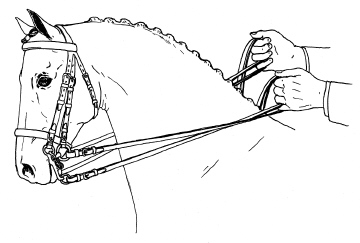
Double Bridle Reins – 2 and 2 Method. Most common handle hold in model horse hobby. It is advised that you put in your comment line what hold your set up is so that judge’s know you understand the three styles on holding the reins.

Double Bridle Reins – 3 in 1 Method. A true challenge for model horse hobbyists and doll rider’s with razor cut slips in the fingers of the hands. Left side curb goes directly back to hand and enters under ring finger with the left snaffle rein coming directly back and entering under the pinky finger with rein crossing over the curb rein. Right side curb rein goes directly back and enters under the middle finger of the left hand with all three reins coming up thru hand and out over the of the index finger with bight cascading down the right side. The right side snaffle goes directly and enters the hand under the ring finger, up into the hand and out over the top of the index finger with the bight draping down the right side. The look gives an ‘X’ to reins the left side of horse’s neck but a two independent rein look to the right side but only one rein going into the right hand. Very tricky set up.
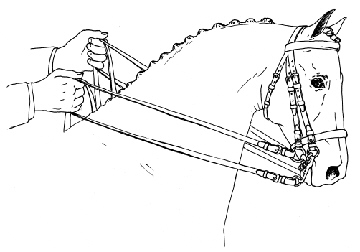
Double Bridle Reins – Fillis Method. The Fillis method of holding the reins is when the curb reins enter the rider’s hand from the bottom, around the little fingers and up to the second joint of the index fingers while the snaffle enters the fist from above over the index fingers. Each hand holds two reins.

